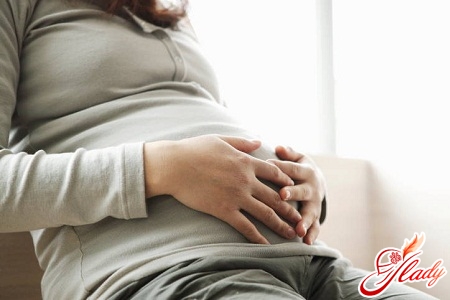 During pregnancy, a woman's bodynumerous changes occur that are necessary for a woman to be able to bear a child. And after childbirth, these organs gradually return to normal. And, of course, it is the uterus that undergoes the most changes. And complications are more common - the uterus after childbirth sometimes does not return to shape right away. This is what this article will be about. However, in order to get a complete picture of what happens to the uterus after childbirth, and what complications can lie in wait in the postpartum period, you need to know exactly how it changes during childbirth. Then it will be much easier to understand everything, and therefore notice the problem in time.
During pregnancy, a woman's bodynumerous changes occur that are necessary for a woman to be able to bear a child. And after childbirth, these organs gradually return to normal. And, of course, it is the uterus that undergoes the most changes. And complications are more common - the uterus after childbirth sometimes does not return to shape right away. This is what this article will be about. However, in order to get a complete picture of what happens to the uterus after childbirth, and what complications can lie in wait in the postpartum period, you need to know exactly how it changes during childbirth. Then it will be much easier to understand everything, and therefore notice the problem in time.
What is the uterus?
First, let's refresh our memory a littleknowledge of what the uterus is. Doctors call the uterus a hollow muscular organ of the female reproductive system. The uterus is a unique organ of its kind - it is in it that the fetus develops, which is why the size of the uterus increases dozens of times during pregnancy, returning to its original position after childbirth. The uterus consists of two main parts - the body of the uterus itself, which is located in the small pelvis, and the cervix. The body and cervix are separated from each other by intermediate tissue, which is called the isthmus. The uterus has a pear-shaped form, located with the cervix down. And the highest point of the uterus is usually called the fundus of the uterus. The walls of the uterus themselves consist of three different layers:
- The outer layer of the uterus is the perimeter, which is also called the serosa.
- The inner layer of the uterus is the endometrium.
The mucous membrane of the uterus changes its structure independing on what phase the menstrual cycle is in. If fertilization has occurred, the endometrium becomes looser so that the fertilized egg can implant into it without much difficulty. At first, until the placenta has formed and begun to function fully, the fertilized egg also supplies the endometrium with nutrients and oxygen. If pregnancy does not occur, the mucous membrane of the uterus (endometrium) separates from the walls and is removed from the uterine cavity along with menstrual discharge.
- And, finally, the middle, intermediate layer of the uterus is the myometrium.
The myometrium makes up the main part of the body of the uterus,and it is this that allows the uterus to increase so much in size during pregnancy. During this period, the bulk of changes, one way or another related to the course of pregnancy, occur in this uterine layer. In order for the uterus to be able to increase as the child grows, muscle cells - myocytes, begin to divide intensively, thus forming muscle fibers. In addition, the growth of the uterus is also ensured by the thickening and lengthening of muscle fibers. By the way, this happens to a greater extent already during the first half of pregnancy. Normally, a woman of reproductive age has a uterus of about 8 centimeters in length, and about 5 in thickness. If a woman has never given birth, her uterus weighs about 50 grams, and in those who have already given birth - about 100 centimeters. At the end of pregnancy, the size of the uterus increases very much - it becomes about 38 centimeters in length, and its weight without fetal membranes and the child is about 1200 grams. In the same case, if the expectant mother has polyhydramnios or a multiple pregnancy, the weight of the uterus can be even greater - up to 1500 - 1800 grams. The uterus begins to increase in size at about 6 weeks of pregnancy - this corresponds to the second week of delayed menstruation. Moreover, at first the uterus increases gradually - first it increases in the anteroposterior size, and then, after a short time - in the transverse size. In the first weeks of pregnancy, during palpation, the doctor determines the asymmetry of the uterus - one of its corners protrudes more than the others. This protrusion is explained by the fact that it is in this place that the fertilized egg has become fixed, which is growing rapidly. Literally in a few weeks, the fertilized egg will become large enough to fill the entire uterine cavity, which will acquire a symmetrical shape. By the end of the eighth week of pregnancy, the size of the uterus doubles, and in just two weeks - already three times. By the end of the first trimester – at 12 weeks of pregnancy, the uterus increases in size four times and exits the pelvis, beyond the upper edge of the pubic symphysis.
Examination of uterine size
So that the doctor can determine correctlywhether the pregnancy is progressing, the doctor must assess the position of the uterus, its size and density. To do this, it is necessary to conduct a two-handed examination of the uterus. To do this, the doctor inserts the middle and index fingers of the right hand into the woman's vagina. And with the left hand, the doctor very gently and carefully presses on the anterior abdominal wall. By bringing the fingers of both hands closer, the doctor will feel the body of the uterus, determining its anatomical features. However, remember that this method of determining the size of the uterus is relevant only in the first twelve weeks of pregnancy. After this, the uterus goes beyond the lower edge of the small pelvis, so the doctor can feel it through the abdominal wall. It is from this period of time that the doctor begins to measure the circumference of the abdomen and the height of the fundus of the uterus. This concept is abbreviated as "VMD". In order to measure VMD and abdominal circumference, the doctor will need either a pelvic meter or at least an ordinary centimeter tape. Before the examination, the expectant mother should visit the toilet and empty the bladder. During all these measurements, the woman should lie on her back. In order to assess the course of pregnancy and fetal development, doctors compare the obtained indicators with established and generally accepted standards. However, remember that, be that as it may, these are only average data, so in each specific case, when assessing the condition of the uterus, the doctor will certainly take into account the individual characteristics of each specific woman - her body type, the course of pregnancy, and much more. However, average figures do exist, and they must be taken into account - a deviation of more than five centimeters is a cause for serious concern:
- 16 weeks of pregnancy - VDM is about 6 - 7 centimeters.
- 20 weeks gestation - VDM is about 12 - 13 centimeters.
- 24 weeks gestation - VDM is about 22 - 23 centimeters.
- 28 weeks of pregnancy - AMD is about 25 - 27 centimeters.
- 32 weeks of pregnancy - AMD is about 30 centimeters.
- 36 weeks of pregnancy - AMD is about 33 centimeters.
- 38 - 40 weeks of pregnancy, the uterus is significantly lowered, and AMD is about 28 centimeters.
As mentioned above, the height of the bottomof the uterus is not a constant value. It can be affected by the amount of amniotic fluid, the number of fetuses being carried - the stretching of the uterus in this case is stronger, which means that the height of the fundus of the uterus will be greater than in a normal pregnancy. The presentation of the fetus is no less important - if it is transverse or oblique, then the VMD will be less than usual. This is why gynecologists almost never determine the gestational age by the height of the fundus of the uterus. Therefore, such facts as the beginning of the baby's movement, the date of the last menstruation, the results of an ultrasound examination of the fetus are taken into account.
Increase in the size of the uterus
In the event that the pregnancy proceedsNormally, a woman practically does not feel the increase in the size of the uterus, because it happens gradually. However, at the very beginning of pregnancy, a woman can experience quite strange sensations in the lower abdomen - this happens because the structure of the uterine ligaments begins to rapidly change and soften. In the same case, if the uterus begins to grow too quickly - due to polyhydramnios or multiple pregnancies, or if a woman's uterus is tilted backwards, or if a woman has scars on the uterus (for example, as a result of a cesarean section), or if a woman has an adhesion process, a woman often begins to experience pain, sometimes quite severe. Often, many women hear advice to endure this pain, supposedly because it is normal and physiological. However, gynecologists advise the expectant mother not to endure the pain, but to seek medical help at its first manifestations. Only a doctor can really assess the woman's condition and establish the cause that led to the occurrence of pain. Otherwise, a woman risks not paying much attention to the pain that signals the beginning of a spontaneous termination of pregnancy - a miscarriage. Strictly speaking, neither a pregnant woman nor one who has already given birth should in any case try to diagnose herself. Often, even the most experienced doctor needs time and certain additional studies in order to accurately establish an accurate diagnosis. And if a woman also seeks help from a doctor at the wrong time, then the most precious time can be irretrievably lost.
What happens to the uterus after childbirth?
What happens to the uterus after birth?baby? Uterine contraction after childbirth begins within a few minutes of the baby's birth. Immediately after childbirth, intensive contraction of the uterus begins to occur so that the placenta separates and moves away from its wall. In the first few hours after the birth of the baby, the height of the fundus of the uterus is approximately twenty centimeters. Then the uterus will descend approximately one centimeter per day for about two weeks. If the contraction of the uterus after childbirth occurs normally, the indicators will be approximately as follows:
- The second day after birth - VDM is approximately 14 - 15 centimeters.
- The 4th day after birth - VDM is approximately 11 centimeters.
- The 6th day after birth - VDM is approximately 9 centimeters.
- The 8th day after birth - AMD is approximately 7 centimeters.
- The 10th day after birth - AMD is about 6 centimeters.
The uterus will finally regain its shape onlyby the eighth to ninth week after childbirth. However, even in this case, it is necessary to take into account some individual factors that can affect this process: the peculiarities of the course of pregnancy and childbirth, breastfeeding, the woman's age, the presence of certain chronic diseases. As a rule, in women over 25, or in those giving birth not for the first time, or in those who had multiple pregnancies or with polyhydramnios, the uterus can contract much more slowly. This means that these women may need medical intervention. The doctor will examine the woman and, if necessary, prescribe special drugs and physiotherapy that will stimulate more intensive contraction of the uterus. While the woman is in the maternity hospital, the doctor has the opportunity to monitor the speed of contraction of her uterus. However, the uterus contracts for much longer than the woman is in the maternity hospital after childbirth. This means that certain problems may remain unnoticed. This is why it is unacceptable to ignore preventive visits to gynecologists under any circumstances. A woman should undergo a gynecological examination two weeks and one month after the birth of the child. The doctor will assess the condition of not only the uterus, but also the cervix. Unfortunately, the cervix after childbirth may also leave much to be desired. But a young mother will need a lot of strength and health to take care of the most precious thing in her life - her baby. But if the problem is not noticed in time, there is a very high risk of developing various complications, due to which the woman may end up in the hospital. We recommend reading:









